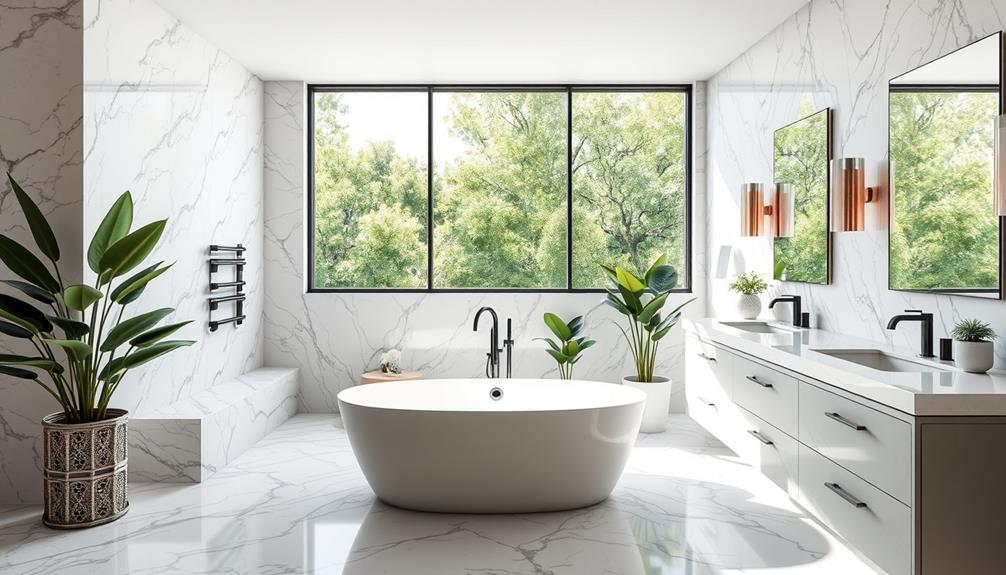To determine costs for bathroom remodeling, start by calculating the expenses for materials and labor. On average, remodels can range from $6,600 to $16,900. Labor typically accounts for 40% to 65% of the budget, so be sure to account for rates for plumbers and electricians. Provide itemized estimates that include any additional charges for specialty work, which can increase the total cost by 20% to 40%. Be sure to allocate a contingency fund of 10-20% for unexpected expenses. Being transparent with clients about these expenses helps build trust and establishes clear expectations. This is just the beginning; continue exploring to discover more insights on effective pricing strategies.
Key Takeaways
- Determine the average cost range for bathroom remodels, typically between $6,600 and $16,900, depending on the scope of work.
- Calculate labor expenses, which generally account for 40% to 65% of total remodeling costs.
- Assess material costs and consider a contingency fund of 10-20% for unexpected expenses.
- Provide detailed, itemized estimates to enhance transparency and set realistic client expectations.
- Factor in potential additional charges for specialty items, permits, and unexpected structural issues.
Understanding Remodeling Costs
When planning your bathroom remodel, understanding the costs involved is vital for budgeting effectively. The average bathroom remodel costs between $6,600 and $16,900, with a national average of around $11,500.
Creating a personal budget can help you track your expenses and guarantee you stay within your financial limits. Your overall expenses will largely depend on the size of the project and your location.
If you're considering a minor remodel, expect to spend between $1,500 and $15,000, which typically includes simple updates like repainting and fixture replacements.
For a midscale remodel, which may involve installing new sinks, toilets, and showers, your budget should range from $3,500 to $20,000.
Major remodels that require significant structural changes can set you back between $7,000 and $30,000.
Keep in mind that luxury remodels with high-end materials can easily exceed these costs. Labor is another significant factor in remodeling costs, usually making up 40% to 65% of your total project bill.
Estimating Labor Expenses
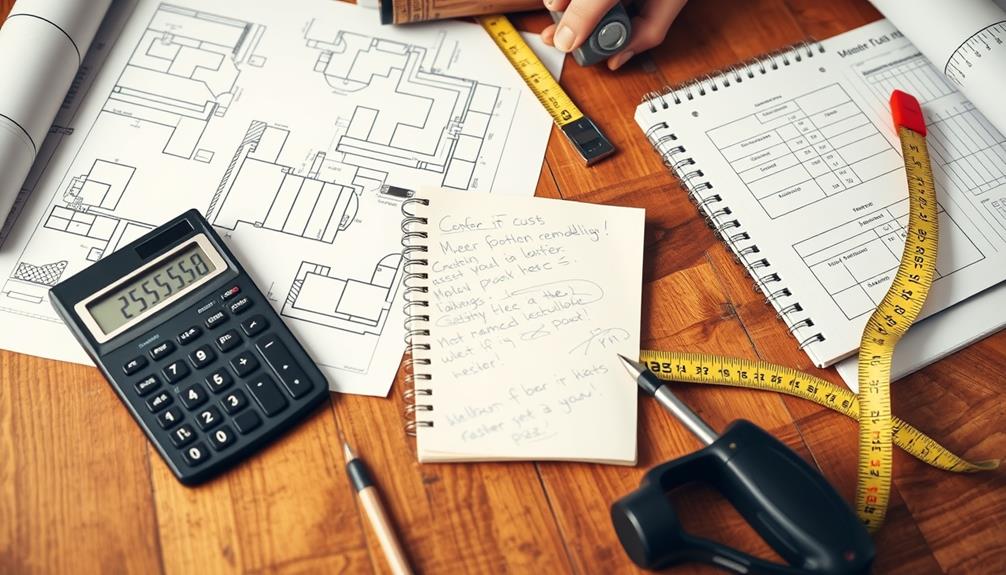
Labor costs play a significant role in your bathroom remodeling budget, often making up 40% to 65% of the total expenses. To effectively estimate labor, evaluate the complexity of tasks. For instance, plumbers typically charge $50-$100 per hour, while electricians range from $60-$120 per hour, depending on the job's difficulty.
Using industry data like RSMeans can help refine your labor cost estimates to reflect current market rates and regional variations. Additionally, keep in mind potential interruptions, such as supply issues or equipment malfunctions, which can impact overall project timelines and costs.
To assist you in estimating labor expenses, refer to the table below:
| Trade | Hourly Rate Range | Factors to Evaluate |
|---|---|---|
| Plumber | $50 – $100 | Complexity of plumbing tasks |
| Electrician | $60 – $120 | Electrical job difficulty |
| General Labor | $25 – $75 | Scope of work and experience level |
| Tile Setter | $40 – $80 | Material type and installation time |
| Painter | $30 – $60 | Surface area and prep work needed |
Keeping detailed records of past projects helps enhance your future estimating accuracy and build a reliable pricing structure.
Material Cost Breakdown
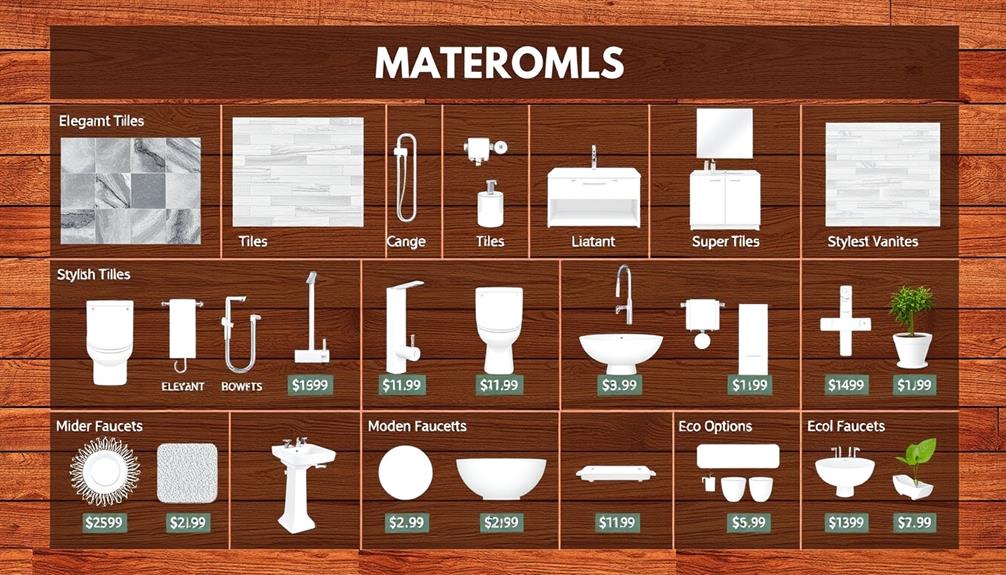
Material costs can vary greatly in a bathroom remodel, often making up a considerable portion of your budget. To guarantee a successful outcome, it's important to conduct effective preparation and gather client preferences early on, as this will help streamline the process.
Budget finishes like vinyl flooring start around $2 per square foot, while high-end options, such as Calacatta Gold marble, can greatly increase your expenses. For mid-range finishes like porcelain tile, expect to pay between $7 and $15 per square foot, and if you opt for a custom tiled shower, the cost to remodel could range from $5,000 to $10,000.
Don't forget about fixtures, as toilets and sinks can range from hundreds to thousands of dollars, depending on the quality and brand. Cabinets and shelving typically account for 25% or more of your total remodeling costs, making careful selection crucial for your budget.
Understanding your unique design preferences can also influence your material choices, revealing surprising insights into your overall style exploration of personal tastes.
When planning, remember to budget for unexpected expenses. It's generally wise to set aside a contingency fund of 10-20% of the total material cost.
Specialty and Additional Charges

Incorporating specialty items and additional charges into your bathroom remodeling budget is vital for an accurate overall estimate. Specialty items, like custom cabinetry or high-end fixtures, can greatly impact your budget, often adding 20% to 40% to the overall project cost. Additionally, it's important to take into account any extra charges that may arise during the remodeling process.
Here's a breakdown of potential specialty and additional charges:
| Item | Cost Range | Notes |
|---|---|---|
| Specialty Items | +20% to +40% | Custom cabinetry, high-end fixtures |
| Equipment Rentals | $50 to $200/day | Varies by tools needed |
| Hazardous Material Remediation | Over $1,000 | Especially if asbestos is present |
| Permit and Inspection Fees | $50 to $500 | Costs vary by location |
When evaluating labor, specialty tasks like plumbing or electrical work might require hourly rates between $50 and $120. By factoring in these specialty items and additional charges, you'll avoid unexpected expenses and guarantee a more accurate remodeling budget.
Common Cost Overruns
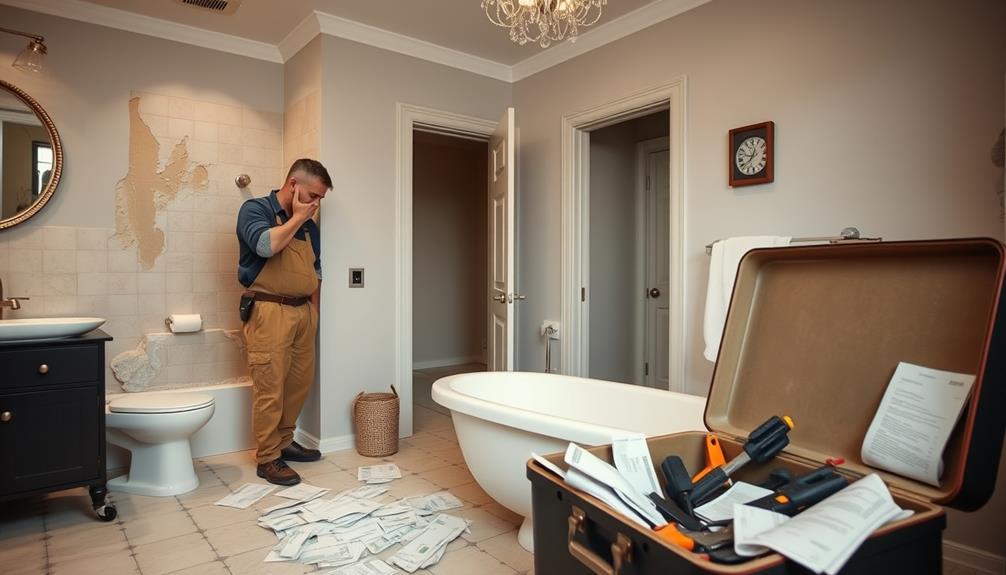
Cost overruns are a common challenge in bathroom remodeling, often stemming from unexpected issues that arise during the project.
These surprise expenses can quickly escalate, impacting your overall budget. Studies suggest that just as astrological compatibility may enhance interpersonal attraction, understanding the compatibility of your design choices with existing structures can help avoid costly surprises.
Here are three common culprits that could inflate your costs:
- Structural Issues: Discovering mold or plumbing problems mid-project can lead to significant increases in expenses. You might've to allocate additional funds to fix these unforeseen issues.
- Design Changes: If you decide to change your design halfway through, be prepared for costs to rise. Homeowners often see a 10-20% increase in their overall budget due to such changes.
- Material Delays: Waiting for custom fixtures can extend your project timeline and increase labor costs as workers may need to stay on longer than planned.
Additionally, don't forget about permitting and inspection fees, which can range from hundreds to thousands of dollars.
Creating Detailed Estimates
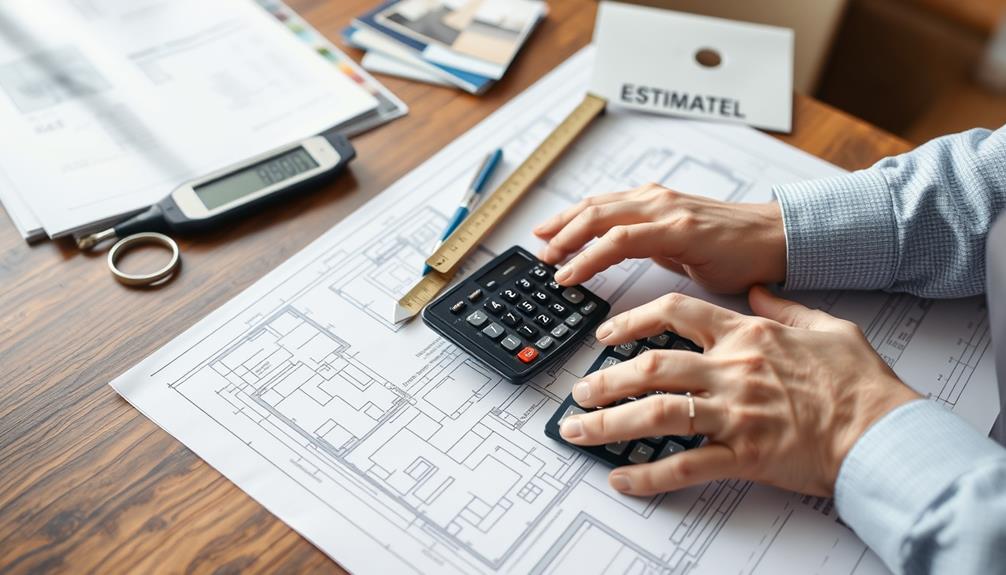
To keep your bathroom remodeling project on track and within budget, creating detailed estimates is key. Start by developing a standard price list for materials and labor, which can help you gauge costs more effectively.
Regularly updating this list to reflect current costs will assist you in formulating accurate estimates, especially when considering top-rated mechanic shops for any plumbing work that may be required. Use itemized lists to break down costs for each component of the remodel, including labor, materials, and supplies. This clarity guarantees your clients understand exactly what they're paying for.
Factor in local market conditions when estimating costs, since regional price variations can greatly impact your overall budget.
It's also wise to incorporate a contingency fund of 10-20% of the total estimated cost. This safety net accounts for unexpected expenses that may arise during the remodeling process.
Importance of Transparency

Transparency is key to a successful bathroom remodeling project. By providing a clear pricing breakdown and maintaining open communication channels, you can build trust with your clients and set realistic expectations.
Additionally, implementing consistent procedures for managing project details can enhance client confidence, similar to how background checks influence hiring decisions.
Presenting detailed estimates upfront also helps prevent misunderstandings and guarantees everyone's on the same page throughout the process.
Clear Pricing Breakdown
A clear pricing breakdown is essential when remodeling a bathroom, as it helps you understand the costs tied to materials, labor, and additional services.
Transparent pricing not only fosters trust but also minimizes disputes down the line. By itemizing costs for each component of the renovation, you can see exactly where your money is going.
Additionally, considering the potential impact of external factors, such as cold medications overview, can also influence your budgeting decisions.
Here are three key areas to focus on:
- Materials: Detail the costs of fixtures, tiles, and other supplies. Knowing the total project cost for materials can help you make informed decisions.
- Labor: Break down the labor costs associated with different tasks, such as plumbing or installation. This clarity can prevent misunderstandings about how much work is required.
- Additional Services: Outline any potential extra fees, like permits or unexpected repairs. Being upfront about these possibilities helps manage your expectations and reduces the likelihood of cost overruns.
Regular updates on pricing changes throughout the project keep you informed and engaged, further enhancing your satisfaction and trust in the remodeling process.
Embracing a transparent pricing approach sets a solid foundation for your bathroom renovation.
Open Communication Channels
Establishing open communication channels is essential for a successful bathroom remodeling project. When you maintain transparency in pricing and keep clients updated, you build trust and foster a collaborative environment. According to Angi, 70% of customers value transparency, so make it a priority to communicate regularly about the project's status and any potential cost changes.
Here's how you can enhance communication:
| Communication Method | Description | Benefits |
|---|---|---|
| Regular Updates | Share progress and changes | Reduces misunderstandings |
| Written Estimates | Provide detailed cost breakdowns | Allows questions and clarifications |
| Digital Tools | Use apps for real-time updates | Improves client engagement |
| Feedback Sessions | Encourage client input | Increases satisfaction rates |
Detailed Estimate Presentation
When you present a detailed estimate, you not only build trust with your clients but also set clear expectations for the remodeling project. This transparency is vital in the home improvement industry, as it helps reduce misunderstandings and potential disputes.
By breaking down costs into clear categories, you give clients a thorough view of their budget allocation. Additionally, just as the presence of security systems can deter potential issues in home safety, a well-structured estimate can prevent disputes before they arise increased safety and peace of mind.
Consider including the following in your detailed estimate:
- Clear Cost Categories: Separate costs into materials, labor, and additional fees to enhance understanding.
- Itemized Pricing: List specific fixtures and labor rates, allowing clients to see the value of each component in the remodeling project.
- Visual Aids: Utilize charts or visuals to illustrate cost distribution, highlighting areas where clients can adjust to fit their budget.
Keep the lines of communication open by regularly updating clients on any changes to the estimate. This guarantees they're aware of any unforeseen costs or savings, further solidifying their trust in you.
Factors Affecting Pricing
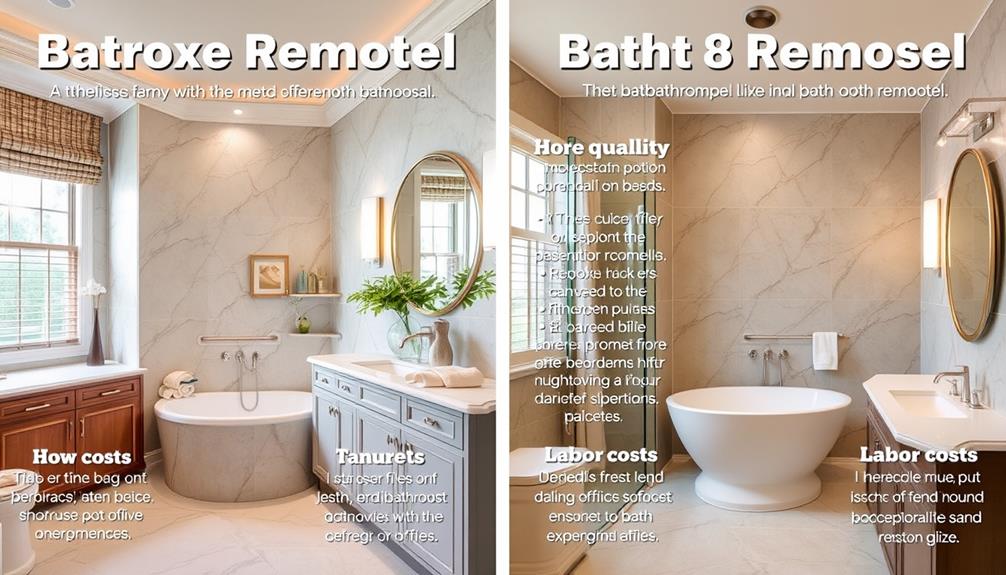
When pricing a bathroom remodel, you need to take into account the quality of materials you choose, as this can greatly impact your budget.
For instance, opting for energy-efficient fixtures can't only enhance the aesthetics but also contribute to long-term savings on utility bills, highlighting the significance of energy-efficient appliances.
Labor complexity also plays a vital role; intricate designs or challenging layouts often require more skilled labor, which can raise costs.
Additionally, customizing your design can lead to higher expenses, so it's important to evaluate your options carefully.
Material Quality Considerations
Material quality plays an essential role in determining the cost of your bathroom remodeling project.
When you're planning your remodel, understanding how material quality considerations affect your total cost is vital. For instance, incorporating natural materials like stone can elevate both the aesthetic and the price.
Here are three key factors to keep in mind:
- Flooring Choices: Budget options like vinyl flooring cost around $2/sq ft, while luxurious materials like Calacatta Gold marble can skyrocket your expenses.
- Fixtures and Fittings: High-end sinks and toilets can run several hundred dollars each, whereas standard models are often available for under $100. Your choice here can greatly impact the overall budget.
- Cabinetry and Shower Units: Custom cabinetry and artisan finishes can add thousands to your project, while pre-fabricated solutions can save you money. Standard tub and shower units are also less expensive and easier to install than custom options.
Labor Complexity Assessment
Understanding the complexity of labor involved in your bathroom remodeling project is just as important as selecting the right materials. Labor complexity can greatly influence your overall costs, often accounting for 40% to 65% of your total project bill.
If your project requires extensive layout changes or structural modifications, you'll likely face higher labor hours, which means increased costs. Moreover, just like with heat pump installation, top-rated heat pumps often require specialized knowledge and expertise, which can also affect labor pricing.
The level of expertise needed for installation plays an essential role as well. For instance, plumbers typically charge between $50 to $100 per hour, depending on their experience. If you're installing multiple plumbing fixtures or making notable adjustments to existing plumbing, expect to pay a premium.
Additionally, the size of your bathroom matters. Larger spaces with more features require more labor to remodel effectively.
Specialty tasks, such as custom cabinetry installation or intricate tile work, also demand skilled craftsmanship and can incur additional labor costs.
Design Customization Impact
A significant factor that affects your bathroom remodeling costs is the level of design customization you choose.
Opting for a basic remodel might set you back around $6,000, while high-end custom designs can easily exceed $50,000. Understanding how various design choices impact your budget can help you make informed decisions.
Here are three key factors to evaluate:
- Material Quality: Mid-range materials typically range from $18,000 to $35,000. Investing in higher-quality materials elevates both the aesthetic appeal and the overall cost.
- Layout Complexity: If you're relocating plumbing or adding custom cabinetry, expect to add 20% or more to your total project cost due to the increased labor and materials required.
- Specialty Features: Adding luxury shower systems or unique tile work can raise material costs by 30-50% compared to standard options.
Client Communication Strategies

Effective client communication is essential for a successful bathroom remodeling project. Start by clearly outlining the scope of work in a detailed contract. This helps manage client expectations and avoids disputes over project costs and deliverables.
Use client communication strategies like visual aids, such as project timelines and cost breakdowns, to facilitate transparent discussions about the remodeling process and associated fees.
Regularly check in with your clients throughout the project. Provide updates on progress and any potential changes to the budget, ensuring they feel informed and involved.
Establish a feedback mechanism to capture client input on design choices and budget concerns. This fosters a collaborative atmosphere that enhances satisfaction.
Educate your clients about the factors that influence remodeling costs, including material choices and labor rates. This promotes understanding and justifies pricing decisions.
By implementing these strategies, you'll build trust, create a positive working relationship, and ultimately lead to a more successful bathroom remodeling project.
Utilizing Technology for Estimates
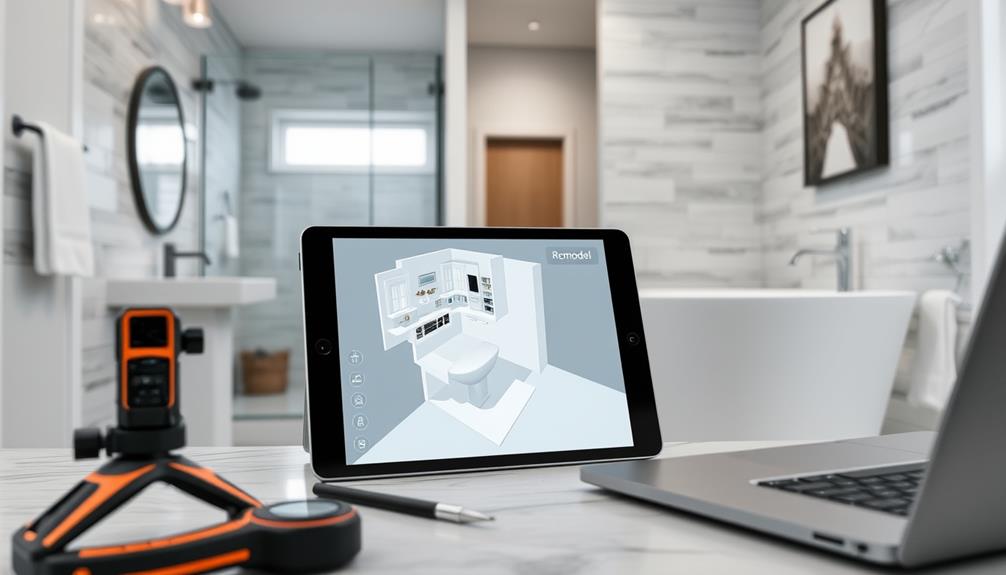
When it comes to charging for bathroom remodeling, utilizing technology can greatly streamline your estimating process. By leveraging the right tools, you can enhance accuracy and efficiency in your estimates, which helps build trust with your clients.
Here are three effective ways to incorporate technology into your estimating process:
- Estimating Software: Use specialized software to calculate costs accurately, ensuring your labor and material estimates reflect current market prices. This minimizes errors and improves your overall reliability.
- Mobile Apps: Employ mobile applications for on-site measurements and project management. These tools allow you to adjust estimates quickly as conditions change during the remodeling process, keeping clients informed and engaged.
- Cloud-Based Platforms: Implement cloud solutions for collaboration with clients and subcontractors. This promotes transparent communication and offers real-time updates on project costs, making it easier for everyone involved to stay on the same page.
Frequently Asked Questions
How Do You Quote a Job Bathroom Remodel?
To quote a bathroom remodel, you'll want to assess project size, labor, and materials. Create an itemized list, factor in unexpected costs, and guarantee your quote reflects transparency and accuracy for your client's budget.
How Much Should Labor Be for a Bathroom Remodel?
Labor for a bathroom remodel typically ranges from 40% to 65% of the total project cost. Consider factors like project complexity and local rates when estimating your labor expenses. Always include contingencies for unexpected issues.
How Much Profit Should a Contractor Make From a Bathroom Remodel?
You should aim for a gross profit margin of 35%-38% on bathroom remodels. This means ensuring your labor and material costs are controlled to achieve a profit of around $5,250 to $5,700 on a $15,000 project.
What Is a Reasonable Budget for a Small Bathroom Remodel?
For a small bathroom remodel, you should budget between $6,000 and $15,000. Consider the extent of upgrades and materials; basic changes might cost around $2,000 to $4,000, while extensive renovations can greatly increase costs.
Conclusion
In summary, charging for bathroom remodeling isn't just about crunching numbers; it's about weaving a transparent tapestry of costs that keeps clients informed. By balancing labor, materials, and any specialty charges, you can avoid common pitfalls and guarantee a smooth process. Remember, clear communication is the key that opens trust and satisfaction. So, embrace technology to streamline your estimates, and watch your business thrive like a well-watered plant in the sun.

